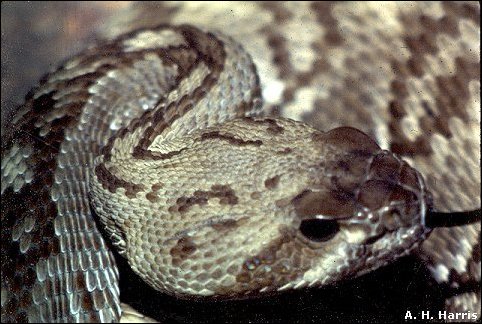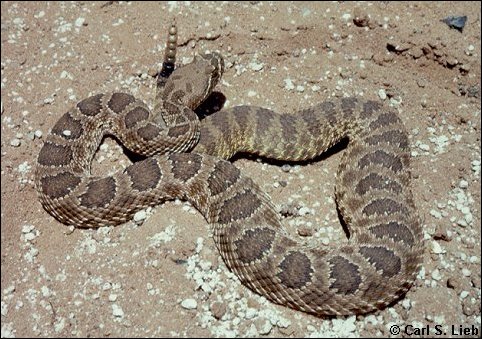
I knew an old man of the desert who liked saying that, "The rattlesnake was a gentleman, because he always gives you a warning before he strikes". Well, that just isn't so.
Myths galore surround the truly painful and dangerous bite of the
rattlesnake. That a snake has to coil to strike, that a snake fang lodged in an old
boot can kill the next person to wear it, that a snake can't bite under water, and
how about this old favorite—that a rattlesnake always sounds its warning rattle
before it bites. In fact, a snake may give no warning at all when accidentally
surprised with a stamping foot, questing hand, or crushing buttock. What the snake DOES
have to do is remember to inject its venom into you. About a third of the time they
seem to forget—or maybe they don't want to waste that precious poison on
something that will be too big to eat? After all, that is what the snake's venom is
primarily for—immobilizing their bird,  lizard, rabbit, or rodent prey—not necessarily to exercise its
"un-gentlemanly" art of self defense.
lizard, rabbit, or rodent prey—not necessarily to exercise its
"un-gentlemanly" art of self defense.
Listen to the Audio (mp3 format) as recorded by KTEP, Public Radio for the Southwest.
Contributor: Carl S. Lieb, Laboratory for Environmental Biology, University of Texas at El Paso.
Desert Diary is a joint production of the Centennial Museum and KTEP National Public Radio at the University of Texas at El Paso.
Degenhardt, W. G., C. W. Painter, A. H. Price. 1996. Amphibians and reptiles of New Mexico. University of New Mexico Press: Albuquerque.
Lowe, C. H., Jr., C. R. Schwalbe, and T. B. Johnson. 1986. The venomous reptiles of Arizona. Arizona Game and Fish Dept.: Phoenix.
Minton, S. A., Jr. and M. R. Minton. 1969. Venomous Reptiles. Charles Scribner's Sons: New York.
Price, A. H. 1998. Poisonous snakes of Texas. Texas Parks and Widlife Press: Austin.
Rubio, M. 1998. Rattlesnake: Potrait of a predator. Smithsonian Institution Press: Washington, D.C.
Wehler, J. E. and J. R. Dixon. 2000. Texas snakes: Identification, distribution, and natural history. University of Texas Press: Austin.
Chiszar, D., C. Radcliffe, K. M. Scudder, and D. Duvall. 1983. Strike-induced chemosensory searching by rattlesnakes: The role of envenomation related chemical cues in the post-strike environment. Pp. 125-139, in Müller-Schwarze, D. and Silverstein, R. M., eds., Chemical Signals III. Plenum Press: New York.
Hayes, W. K. 1991. Ontogeny of striking, prey-handling and envenomation behavior of prairie rattlesnakes (Crotalus v. viridis). Toxicon 29(7):867-75.
Hayes, W. K., I. I. Kaiser, and D. Duvall. 1992. The mass of venom expended by prairie rattlesnakes when feeding on rodent prey. Pp. 383-88, in Campbell, J. A. and E. D. Brodie, Jr. (eds.) Biology of the Pitvipers. Selva: Tyler, Texas.
Kardong, K. V. 1986. The strike behavior of the rattlesnake, Crotalus viridis oreganus. J. Comp. Psychol. 100:304-14.
Kardong, K. V., and V. L. Bels. 1998. Rattlesnake strike behavior: Kinematics. J. Experimental Biology 201(6):837-50.
Russell, F. E. 1980. Snake venom poisoning. Scholium International: Great Neck, New York.

Western Diamondback Rattlesnake

Black-tailed Rattlesnake.

Mojave Rattlesnake .

Prairie Rattlesnake.

Massasauga.
Gorp has information about snakebite.